Introduction- Best Indoor Exercises for Diabetes
With the ongoing pour, an early morning walk or a good run has become quite a task. Well, it’s time to ditch the raindrops and sweat it out indoors. Indoor exercises can make monsoon fitness look easy. This is a real win for diabetics! Lack of physical activities, regular exercise, and a vibrant social life can be challenging for you if your blood sugar levels have been on the rise. Read on to explore various safe, effective, and enjoyable indoor exercise for diabetes for you and your loved ones this monsoon season.
Importance of Exercise for Diabetes
Regular exercise for diabetes is a must; here are a few reasons why:
- ● Exercise increases insulin sensitivity and glucose uptake, which helps control blood sugar levels.
- ● Physical exercise promotes weight loss, healthy weight maintenance, and improved blood sugar regulation.
- ● Exercise helps to build heart muscle, lowers blood pressure, and lowers the risk of heart disease and stroke.
- ● Regular exercise enhances the body’s sensitivity to insulin, lowering the need for medication.
- ● Exercise helps reduce stress, which can have a negative impact on blood sugar levels.
- ● Fitness, energy levels, mood, sleep, and immune function are all improved by exercise.
- ● Regular exercise helps maintain blood sugar control over the long term and lowers the risk of complications from diabetes.
No Equipment Exercise for Diabetes
- ● Yoga and Pilates : Yoga and Pilates are low-impact workouts that improve strength, flexibility, and relaxation. They can be done indoors with little space and equipment. These exercises help to reduce stress, improve posture, and improve overall well-being. Look for beginner-friendly yoga or Pilates videos online, or join virtual classes led by experienced instructors.
- ● Chair Exercises : Chair exercises are a good option for people who have limited mobility or joint problems. These exercises can be done while seated in a stable chair. Chair exercises help to improve flexibility, strength, and circulation. They are especially beneficial for diabetics who may suffer from neuropathy or balance problems. Look for chair exercise routines that are specifically designed for people with diabetes.
- ● Circuit Training : Circuit training entails performing a series of exercises targeting different muscle groups in rapid succession, with little rest in between. It works out the entire body, improves cardiovascular endurance, and increases metabolism. Create your own circuit training routine or watch online videos that are appropriate for your fitness level. For an effective indoor workout, incorporate exercises like jumping jacks, squats, push-ups, and planks.
- ● Dancing : Dancing is a fun and enjoyable way to stay active while fighting the monsoon blues. It aids in the improvement of flexibility, balance, and overall cardiovascular health. Join a dance class or simply dance at home to your favorite music. You can try Zumba, salsa, hip-hop, or even freestyle dancing. Dancing not only keeps you physically active but also improves your mood.
With Equipment Exercise for Diabetes:
● Walking or Jogging on a Treadmill
Walking or jogging is a low-impact exercise that helps manage blood sugar levels and improves cardiovascular health. Investing in a treadmill allows you to continue this activity indoors, regardless of the weather outside. Begin with a brisk walk and gradually increase the speed or incline to suit your fitness level. On most days of the week, aim for at least 30 minutes of moderate-intensity walking or jogging.
● Indoor Cycling
If you enjoy cycling, consider purchasing a stationary exercise bike. Indoor cycling provides an excellent cardiovascular workout while minimizing joint impact. Set the resistance level to your fitness level and pedal away. To make the experience more engaging and challenging, you can use pre-recorded cycling classes or virtual cycling programs.
● Yoga and Pilates
Yoga and Pilates are low-impact exercises that promote strength, flexibility, and relaxation. They can be practiced indoors with little space and equipment. These exercises help reduce stress, improve posture, and improve overall well-being. Look for a beginner-friendly yoga or Pilates class virtually for the best results.
● Resistance Training:
Resistance training, also known as strength training or weightlifting, is essential for diabetes management. It aids in muscle growth, metabolism, and insulin sensitivity. Resistance exercises can be done with resistance bands, dumbbells, or your own body weight. Concentrate on exercises that target major muscle groups, such as squats, lunges, push-ups, and planks. Start with lighter weights and gradually progress as you get stronger.
Conclusion
In the battle against diabetes, exercise is honestly the biggest organic weapon—it is in your hands to use it or waste it. Exercise for diabetes helps with weight reduction, better blood flow, and optimal hormonal functions. Do not let the monsoon season derail your diabetes management plans. Engaging in regular physical activity, regardless of the weather outside. Remember to consult your diabetologist before beginning any new exercise regimen, especially if you have any existing health conditions or concerns. Stay motivated, stay active, and use the monsoons to prioritize your health.








